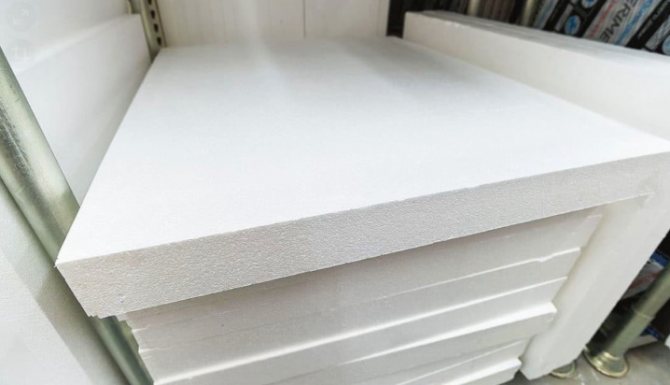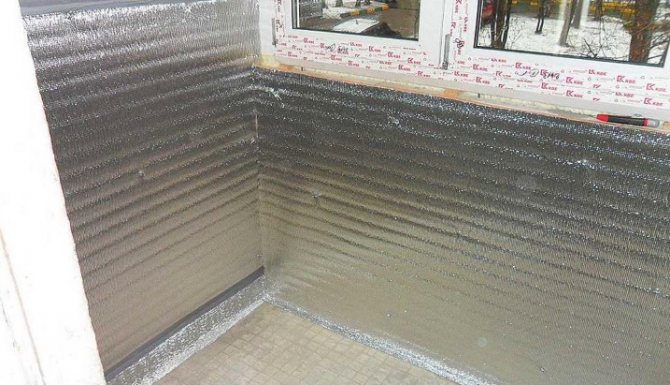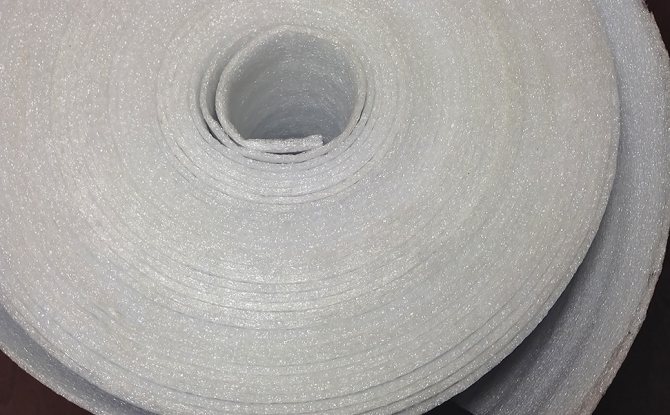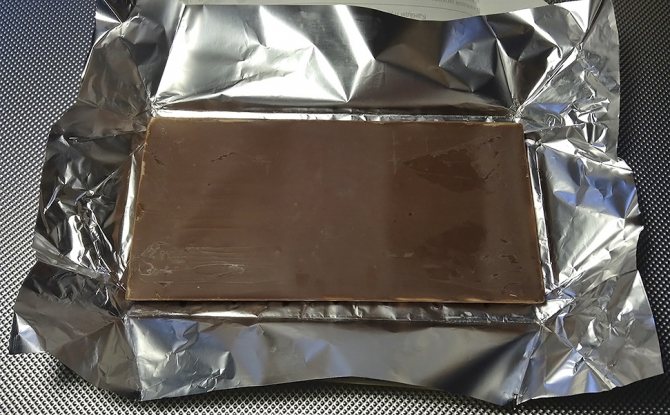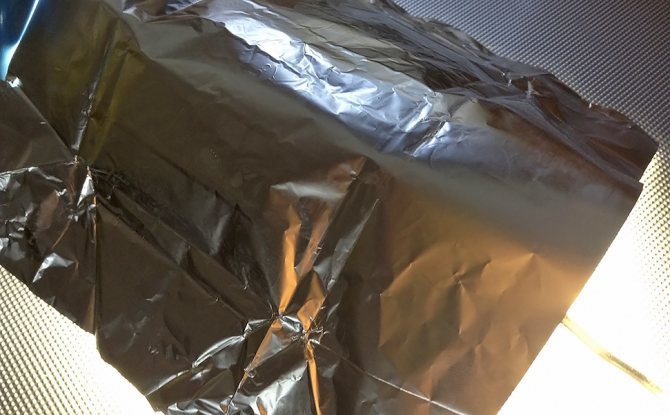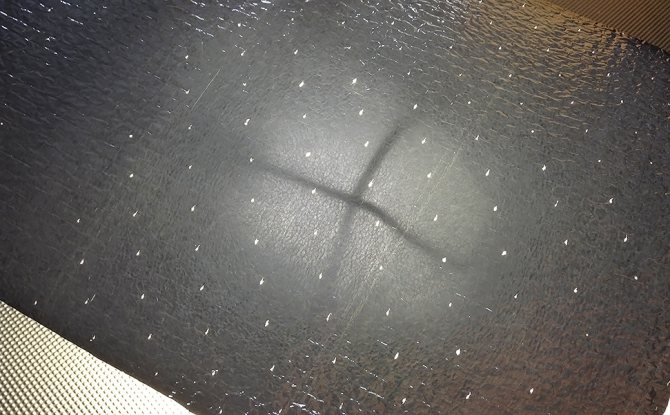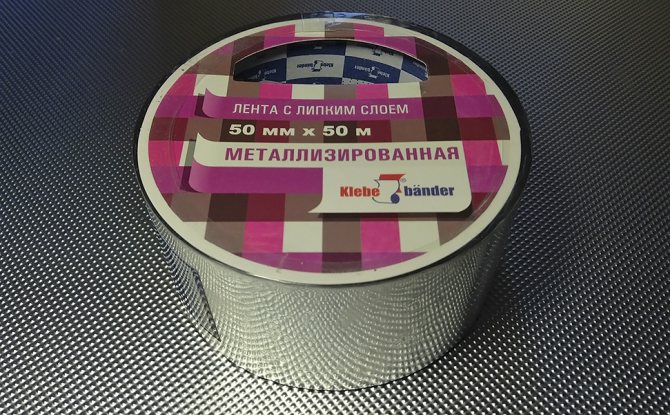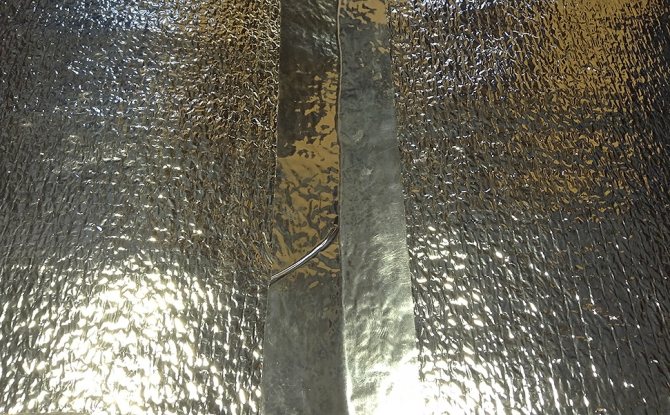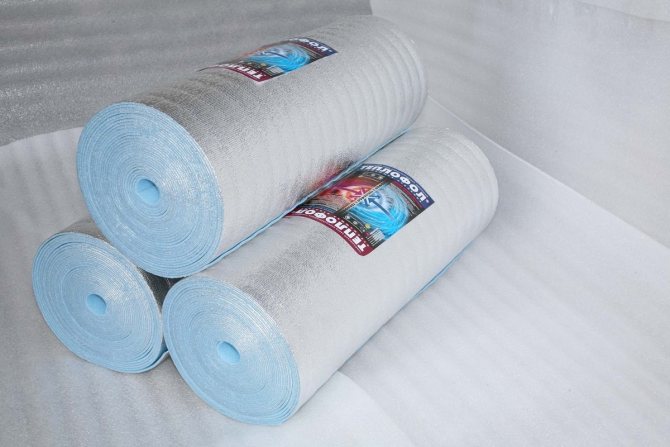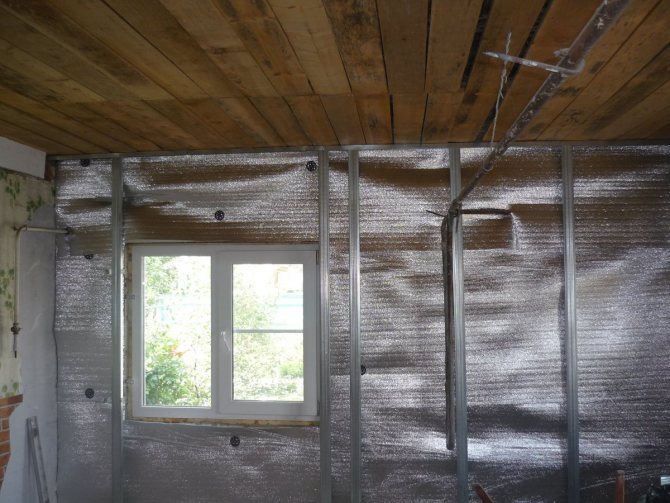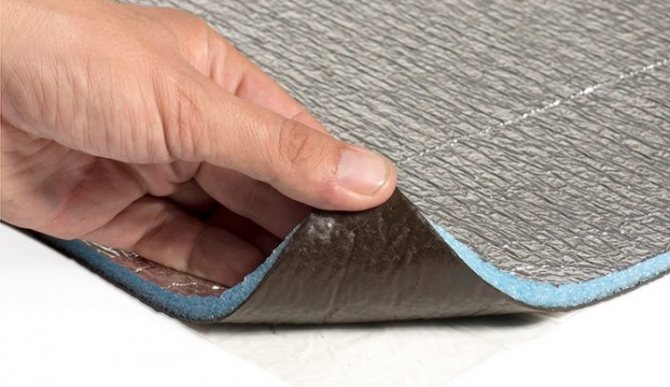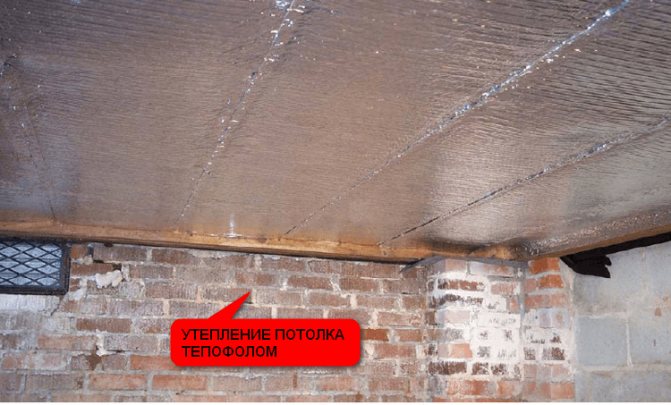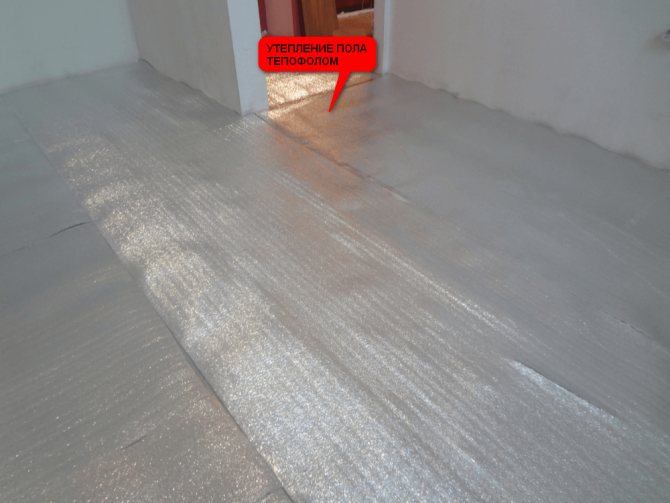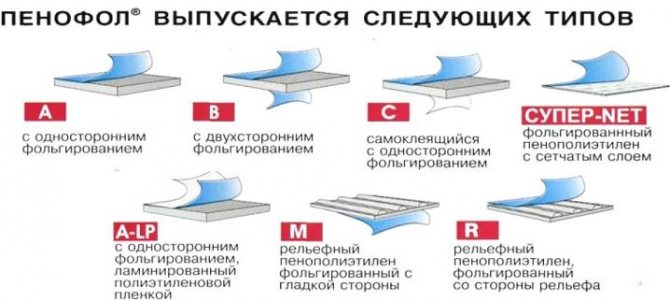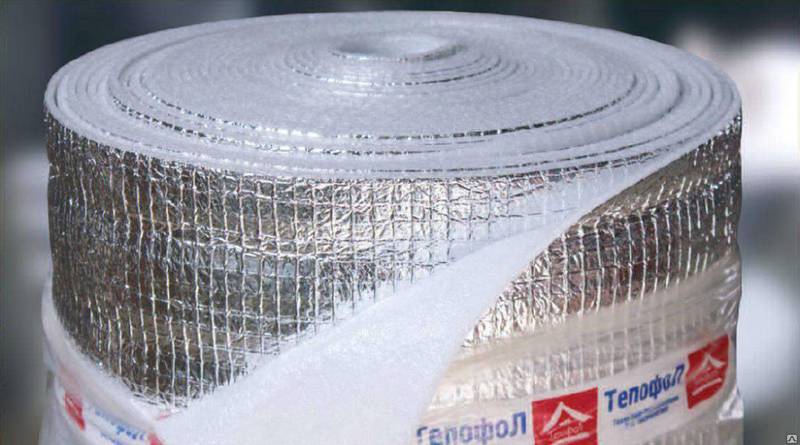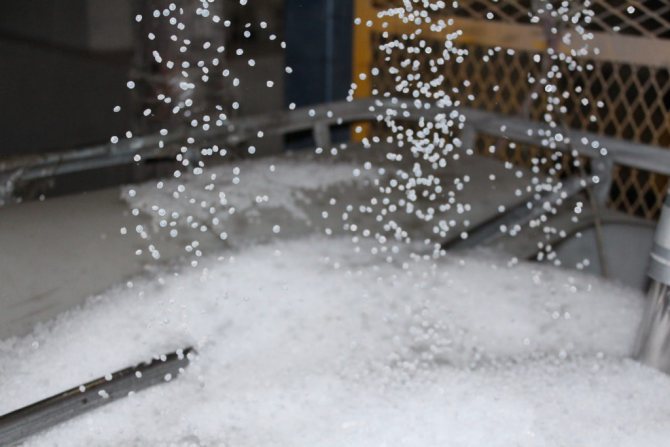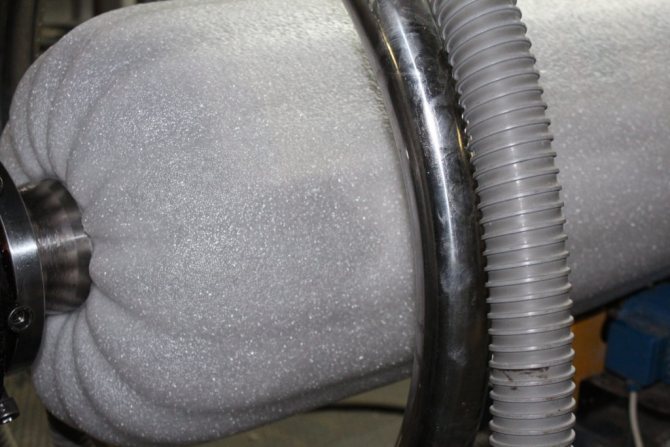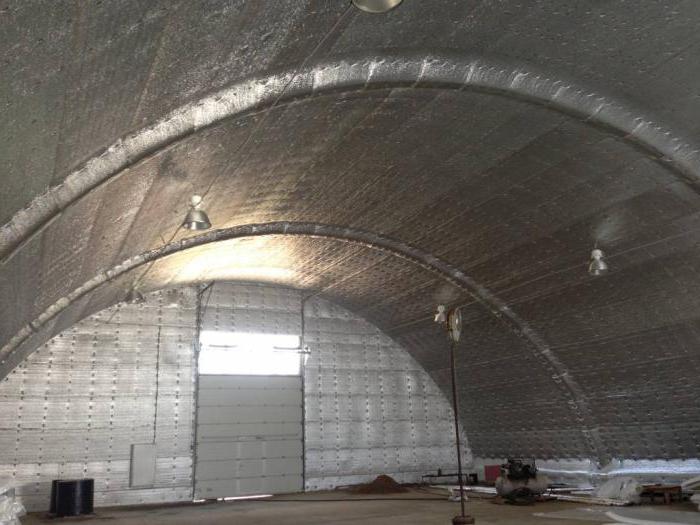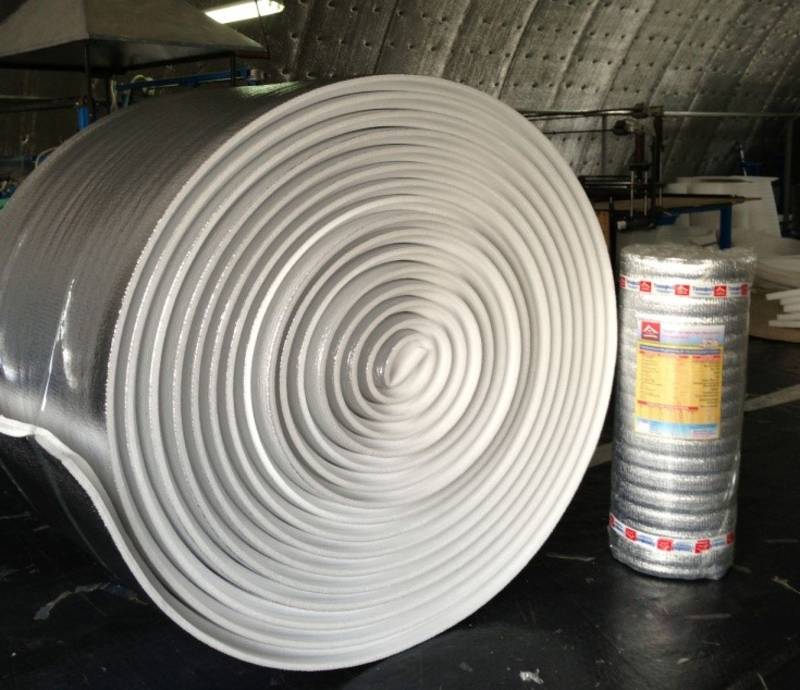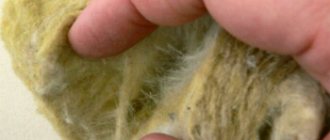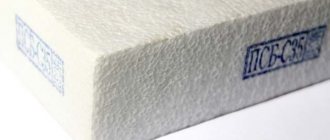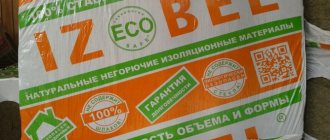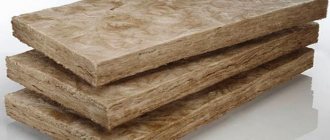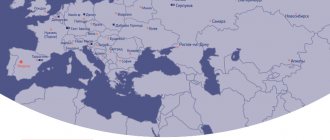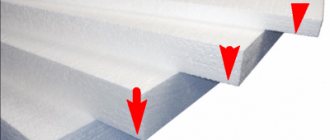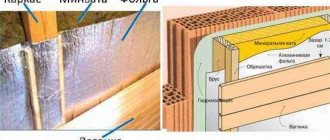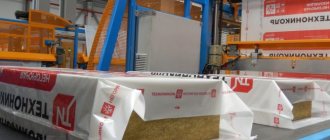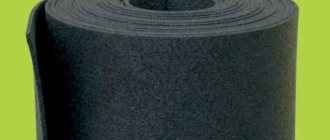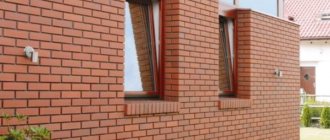Penofol properties
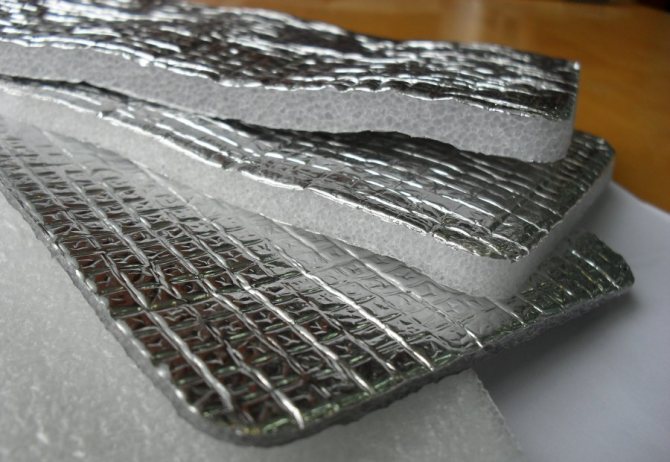
Foiled penofol is an insulating material with a reflection effect, which has a multilayer structure. The main purpose is to drain drafts or wind streams from building structures, to eliminate condensation or moisture, steam that rises up the tiers. Also, the material isolates external noises or sounds. It is a universal type of insulator, since it increases sound insulation, vapor barrier, protects against moisture and retains heat. Such features are due to the structural organization of the material and the technology used in production.
The bulk of the material is foamed polyethylene... In this case, the pores formed on it are closed and filled with air. Such polyethylene foam is used in the form of skeins with different densities, thicknesses and different internal structures. Either on one or on both sides, based on the purpose of the material, polyethylene is covered with aluminum foil. Before application, it is processed and polished to a high gloss with a maximum reflectivity (up to all 97% and even more). More often, the foil is applied using heat welding, which provides better adhesion of the material.
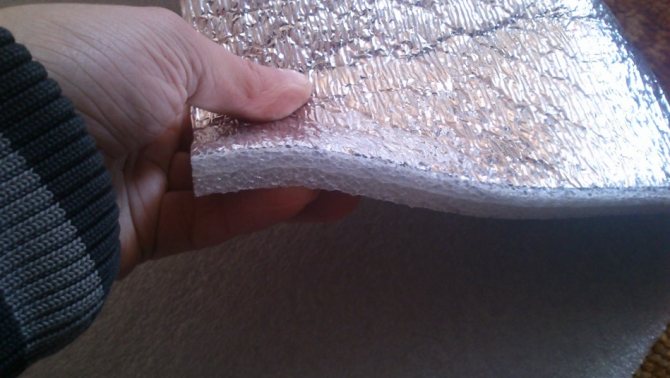

The thickness of penofol is from two to ten millimeters, the foil is only from 12 to 30 microns. The thickness of the material can be increased to 40 mm, if it is necessary to create especially strong thermal insulation, for example, in an arctic climate.
Penofol is based on the well-known principle of "Dewar vessel" in physics. At the beginning of the last century, James Dewar established that every substance has some kind of resistance to heat transfer. Whatever this indicator may be, the material can only suspend or make the movement of heat slower, however, not stop it at all. In this case, heat waves are collected in the substance and energy is accumulated inside the substance, after some time, a supersaturation is created, after which any material becomes a source of heat itself.
Experimenting further, Dewar isolated several substances that did not absorb thermal energy, but reflected. Among those were all the precious metals (platinum, silver and gold), as well as polished aluminum. In this case, heat rays are reflected from surfaces by almost 100%. These reflectors themselves are excellent heat conductors and should be used in conjunction with heat sinks.
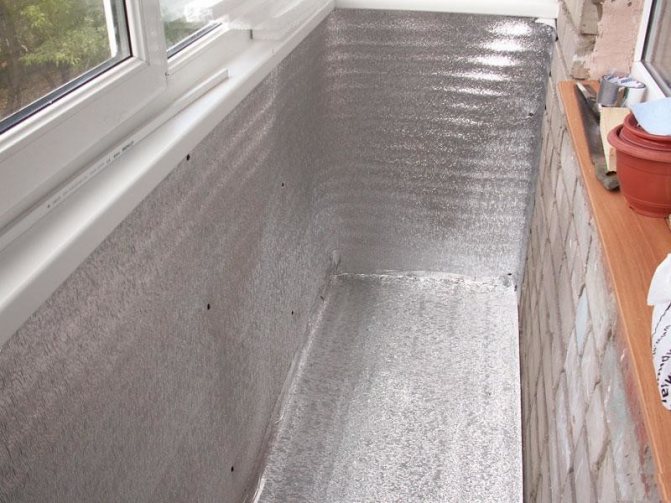

A common thermos is arranged in approximately the same way, and Dewar's research became the basis for the creation of space suits and materials for thermal insulation with a reflective effect.
The use of both double-sided and single-sided insulators reduces the cost of heating the premises in winter, and in warm summer weather does not allow the house to heat up too quickly.
Consumer reviews about the varieties of "Tepofol"
"Tepofol", reviews of which are often only the most positive, is presented for sale in several varieties. Each of them is designated by a specific letter, which indicates quality characteristics. According to users, under the letter A, the manufacturer produces "Tepofol" with a reflective coating, the latter of which is aluminum foil. Sometimes it is replaced by a polished metallized film.
Consumers quite often choose Tepofol insulation, which is denoted by the letter B. It has a double-sided coating of aluminum foil and metallized film.As users emphasize, self-adhesive material is designated by the letter C. By the way, on the one hand it has an aluminum coating, on the other - a metallized film. On sale you can find "Tepofol", which has the name "Metal". In this case, a metallized film is used as a reflective layer. If necessary, you can also purchase IPE. It is a polyethylene foam backing.
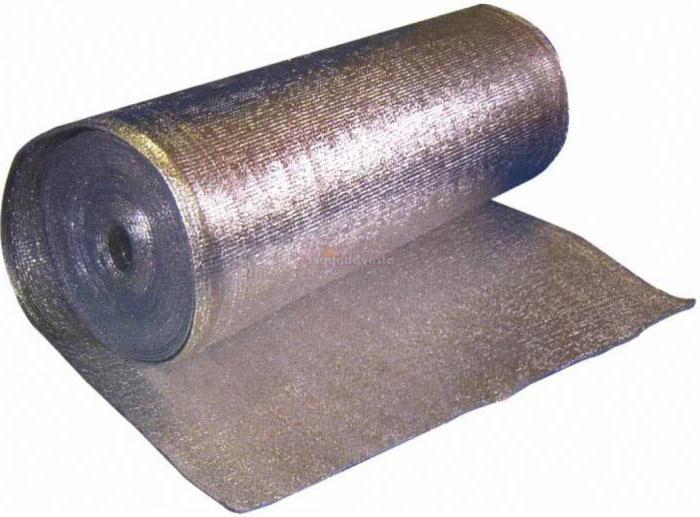

View gallery
Pros and cons of penofol
When using penofol for insulation, the following advantages can be distinguished:
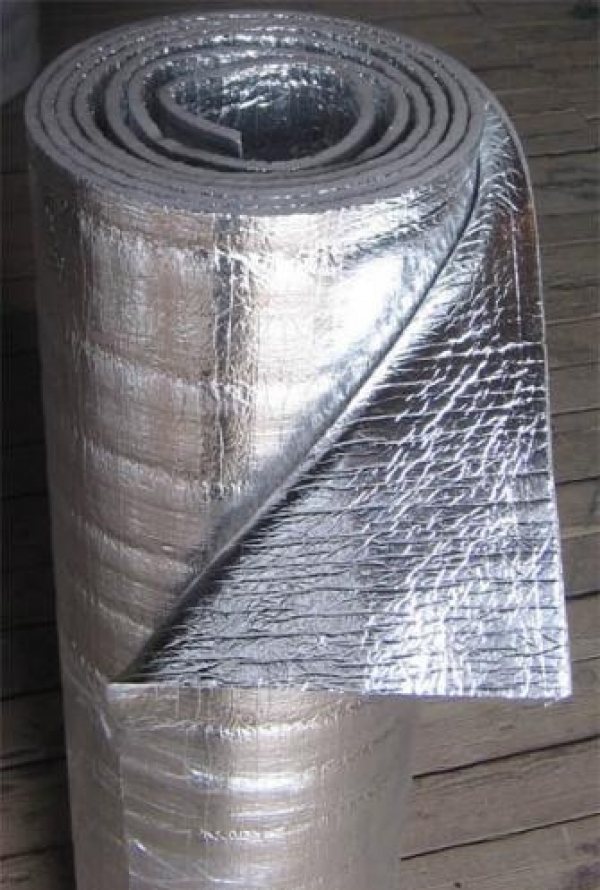

- Penofol possesses versatility of use - the material can be used during construction and repair work, outside or in the internal insulation of premises. For example, for balcony insulation.
- It has minimal vapor permeability from the side of the insulation, which makes it possible to apply penofol without additional vapor barrier material.
- It gives good insulation from noise, it is often used in houses, in workshops against acoustic noise.
- Compared to other insulators, the material is quite thin. Penofol on two sides 4 mm thick can replace mineral wool laid out with a thickness of 8.5 cm, a pine interlayer of 1.8 cm or as much as 3 cm of expanded polystyrene with extrusion.
- Penofol easy to mount... This material is lightweight, it makes it possible to install thermal insulation without assistance. For work, no extra tools are needed, the sheet of material is simply cut with a knife, you can fix it with a stapler for furniture, small nails, or tape.
- Penofol made from environmentally friendly materialsthat meet all sanitary requirements. The substances from which it is made are used to store food, and some of the manufacturers even warn that penofol will protect against increased radiation.
- This heat-shielding material is hardly flammable, which significantly increases the level of fire safety in an insulated room.
- It is too thin for rodents who like to make minks in other insulation can start in it.
- Penofol is convenient to transport, the canvas is collected in rolls, they can later be hidden in the trunk of a car.
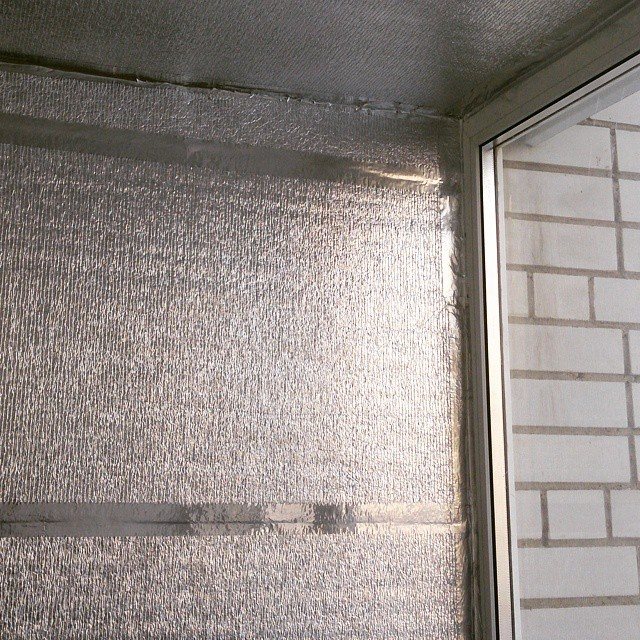

Even taking into account the huge variety and number of advantages of foil-clad penofol, it also has a number of disadvantages:
- The material is quite soft, which limits its possibilities.It will not work for wallpapering or plastering.
- For fixing, you may need to purchase specialized glue. True, there are self-adhesive material options.
- Experts recommend not using this material as an insulated external insulation for buildings. It can be attached to reflect heat energy or to protect the entire structure from internal moisture in a separate layer.
Features of installation work
The creation of a heat-shielding layer using Tepofol is possible both from the outside of the building and from the inside. The cladding of the inner walls with the material complies with sanitary standards due to the ability of the insulation to pass vapors, which does not interfere with the natural circulation of air. The insulation technology is simple, you can cope without the involvement of skilled workers.
When performing installation work, the following points must be taken into account:
• a layer of insulation in a heat-shielding structure on both sides should be surrounded by ventilation gaps;
• when laying the material, pay attention to the location of the metallized sheet, the foil is directed towards the dwelling to reflect thermal energy;
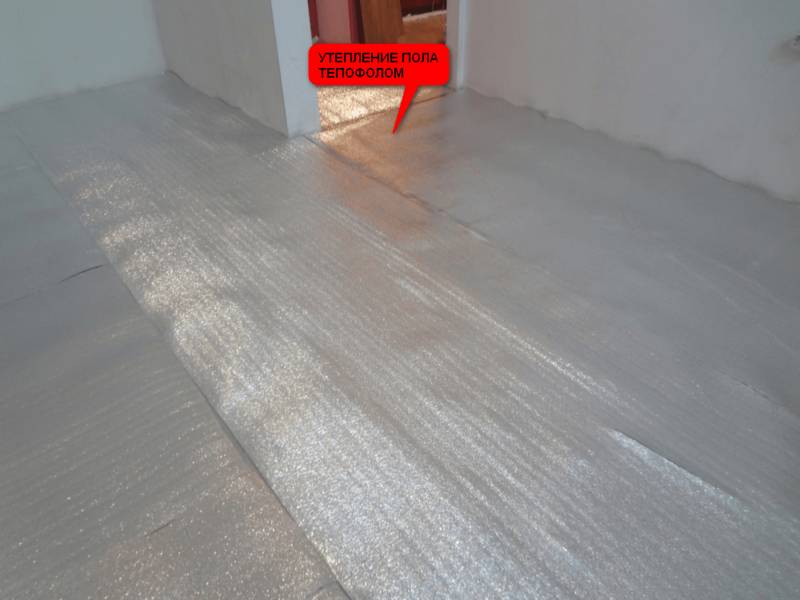

• the canvases should be joined with an overlap with the approach to the previous strip by 10 cm, in addition, the connection is fixed with adhesive tape;
• a frame made of wooden blocks is packed in compliance with an interval not exceeding 1 m;
• the most effective is thermal protection, equipped from the outside of the dwelling.
It is recommended to start work with surface preparation. It needs to be carefully examined for cracks and holes. They are covered with plaster mortar. If yellow or gray spots are found on the wall, they must be cleaned with a metal brush, and then treated with an antiseptic solution, passing several times at the site of possible damage by the fungus.
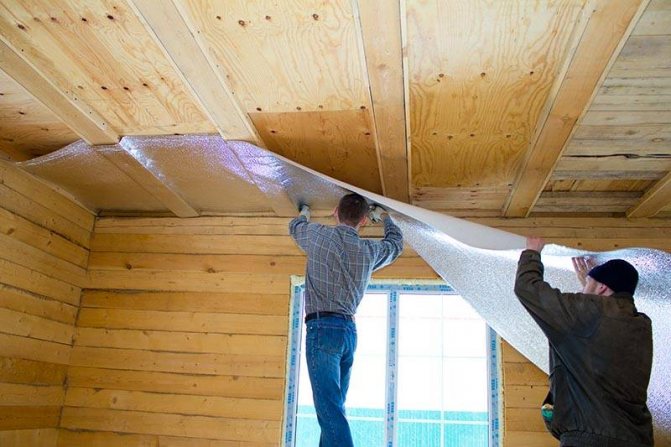

Further installation is carried out in the following order:
• on the surface dried after processing, a grate is stuffed - a frame for a heat insulator (for this, wooden blocks are used that have been treated with an antiseptic and fire retardant);
Penofol types
For different functionality, manufacturers offer different penofol options. The generally accepted classification subdivides three of its types:
- A type - one-sided penofol (aluminum film is applied to one side of polyethylene after foaming). This type is used more often as an additional heat insulator with foam;

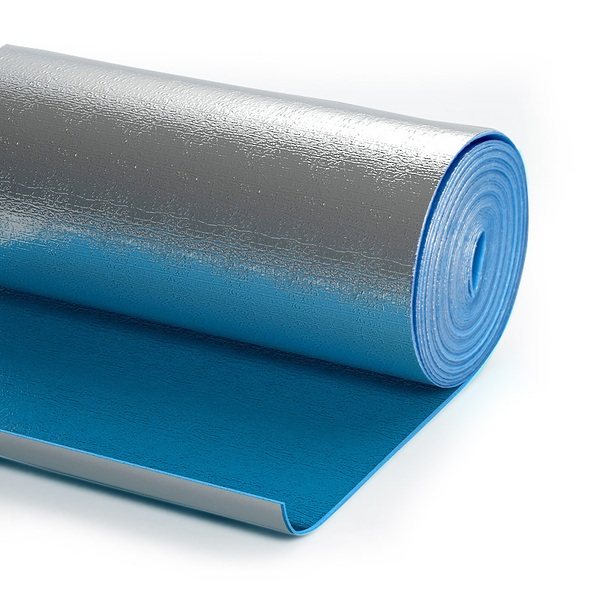
Penofol type A - B type - penofol foil on two sides, has universal application, including for autonomous isolation;
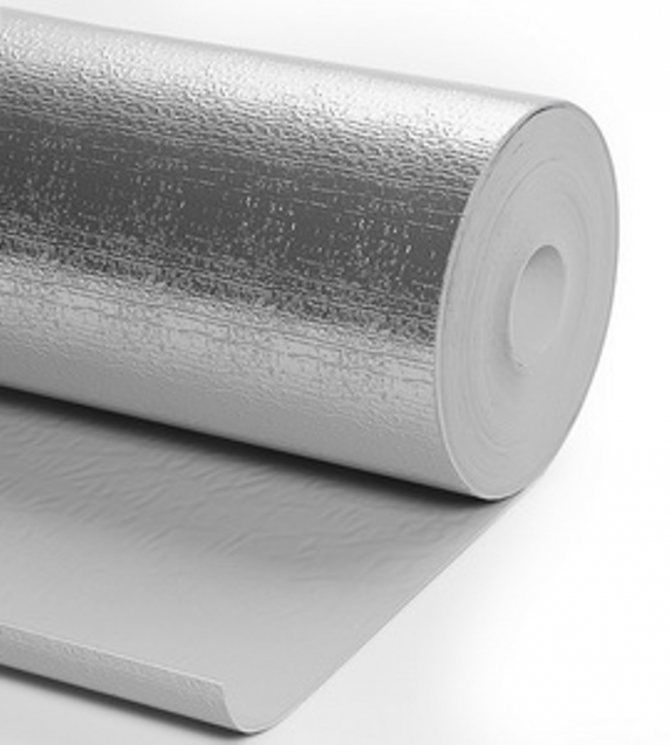

Penofol type B
- C type - self-adhesive. On one side there is a reflector layer on aluminum, on the opposite side there is a moisture resistant adhesive on polyethylene foam, which is protected by a sticker. Such penofol is more convenient for finishing areas that are difficult to reach. During installation, no special installation tools are required.
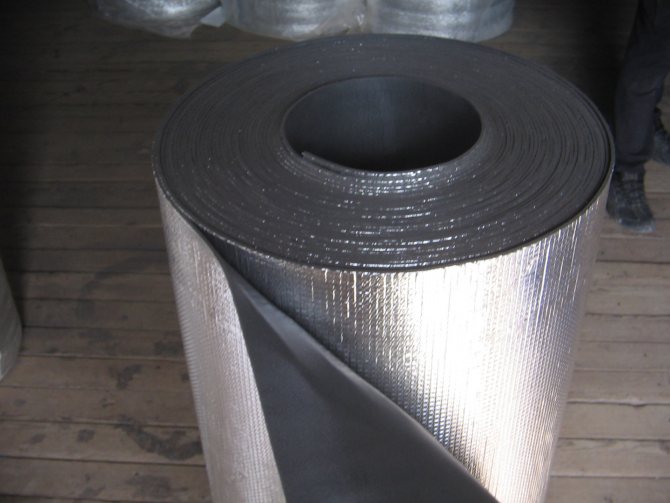

Penofol type C
In addition to these standardized types, the developers have also prepared modifications that occupy a separate niche in the building materials market:
- ALP type - penofol with lamination, there is a plastic wrap on the foil side. This type of material is used to insulate agricultural buildings, operated in a not too aggressive environment;
- M or R types - one-sided foil with corrugated "top";
- AIR - penofol used for the preparation of air outlet structures;
- Super NET (from the word "Network") - the main task of this type of penofol is body insulation and protection from steam for air outlets, pipelines or heating mains.
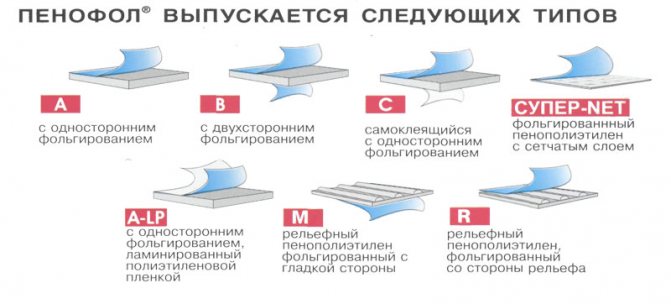

Insulation advantages
- Low thickness with highest efficiency. The material does not require increasing the thickness of the walls, as well as the height of the floor, since its thickness is very insignificant;
- Flexible structure and convenient installation process. The latter is made directly to the wall. In the case of concrete or brick, the material is attached to adhesive tape, but Teplofol can be adapted to other building materials using a construction stapler. In general, it is combined with a large number of different building materials;
- The material can serve as a substrate for parquet, laminate or other floor finishes. In this case, the foil simply reflects heat from the room, preventing it from penetrating into the structural elements of the room and going into the ground;
- With insufficient insulation of the roof and walls, the installation of Teplofol allows you to bring this indicator to the required norm. In addition, the material also excellently protects against noise, absorbing sounds of at least 35 dB. Quite a good solution for absorbing noise from above. It is relevant when you need to protect the premises from the bottom from the noise and stomp of children;
- Only 4 millimeters of Teplofol equals 48 millimeters of expanded polystyrene, 60 millimeters of polystyrene, 77 millimeters of mineral wool, 120 millimeters of wood, 330 millimeters of foam concrete or a whole 650 millimeters of brick;
- Elasticity and at the same time one hundred percent stability of the original shape even after many years. In general, it does not lose its properties for many decades, while not requiring any maintenance;
- Excellent moisture resistance without compromising its performance;
- Low price. The cost of Teplofol at the moment is about 80 rubles per square meter, but the cost of one 20-meter roll usually reaches 1400 rubles;
- Teplofol is safe from the point of view of rodents, insects and various fungal infections. Resistant to mechanical damage and corrosive processes.
Important! Despite the numerous advantages of Teplofol, it must be understood that this is not the main material for insulation, and best of all shows itself in an additional role. At the same time, Teplofol still needs ventilation.
Penofol characteristics
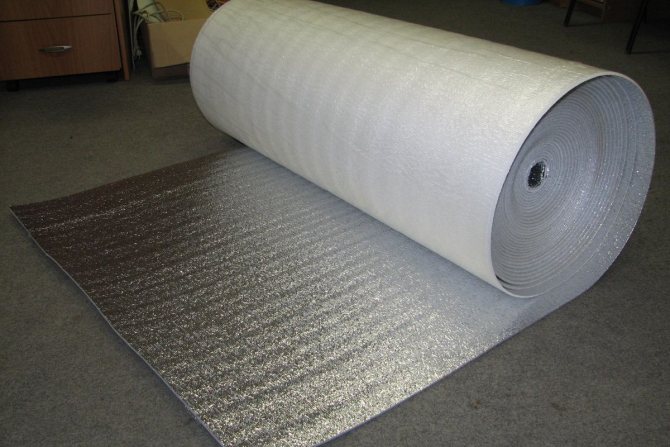

This material has the following performance characteristics:
- operating temperatures range from -60 ° С to + 100 ° С;
- thermal reflection on the surface reaches 95 - 97%;
- thermal conductivity indices depend on the conditions in which the material is used and fluctuate between 0.037 and 0.052 W / m ° C;
- moisture absorption per volume is from 0.35 to 0.7%, this value guarantees high-quality protection of the frame or floor from possible moisture ingress;
- if the thickness is 4 mm, then the specific weight will be 44 or up to 74 kg / m3 (this indicator strongly depends on the type of material);
- vapor permeability is no more than 0.001 mg / m h - penofol is an excellent protector against fumes;
- ultimate compressive strength - up to 0.035 MPa;
- specific heat capacity is 1.95 J / kg ° C;
- sound is absorbed - not less than 32 dB.
More technical characteristics of foil-clad penofol can be found in the table below.
| Characteristics | Penofol types | Units | ||
| Type A | Type B | A type C | ||
| Optimum temperature | from - 60 ° C to +100 ° C | ° C | ||
| Thermal reflection coefficient of the surface | ≥ 95-97 | % | ||
| Thermal conductivity coefficient (I) in dry state at 20 ° С | ≤ 0,037-0,049 | ≤ 0,038-0,051 | W / m ° C | |
| Water absorption by volume | ≤ 0,7 | ≤ 0,6 | ≤ 0,35 | % |
| Specific gravity (with a thickness of 4 mm) | 44 + / — 10 | 5 4 + / — 10 | 7 4 + / — 10 | kg / m3 |
| Dynamic modulus of elasticity (Eq) - under load 2 Kpa - under load 5 Kpa | 0,26 0,77 | 0,39 0,72 | 0,26 0,77 | MPa |
| Compression ratio (Eq) - under load 2 Kpa - under load 5 Kpa | 0,09 0,20 | 0,03 0,12 | 0,09 0,20 | units |
| Heat assimilation coefficient (S) with a period of 24 hours | 0,51 | 0,45 | 0,51 | W / m² ° С |
| Vapor permeability | ≥ 0,001 | mg / m h Pa | ||
| Compressive strength | ≥ 0,035 | MPa | ||
| Reduction index of the reduced level of impact noise | A3003-17 | A3005-19 | A3010-21 | dB (A) |
| Specific heat | 1,95 | J / kg ° С | ||
Size Reviews
It is important not only to correctly install the insulation, but also to choose the thickness and length of the material. The first parameter ranges from 2 to 10 mm. This, in the opinion of buyers, is very convenient, since you can choose the thickness depending on the goals pursued. But the length of the roll can be equal to 15 or 25 m. As for the width, it is 1.2 or 1.05 m. Buyers claim that these parameters make it easier to carry out work on the preparation and strengthening of the material to the surface.
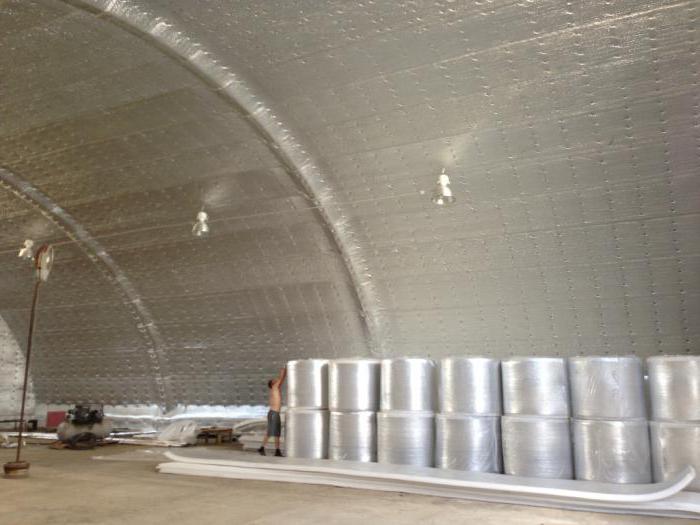

View gallery
Penofol application
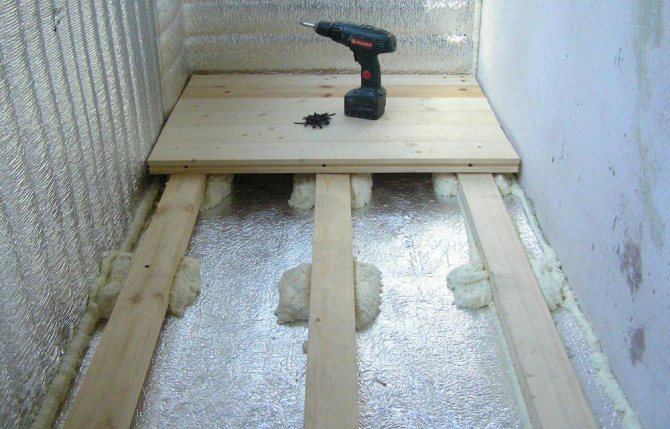

A universal type of material is well suited for insulation of multi-storey buildings or a summer house in the country. The material is known and popular in both renovation and fundamental construction.
Penofol is widely used in construction:
- With thermal insulation:
- in hangars or warehouses, heated or cold;
- living quarters;
- for refrigerators, vans or railroad cars, in cars;
- saunas or baths;
- during the construction of children's medical institutions;
- industrial buildings and administrative complexes;
- during the construction of shopping centers, shops, and so on;
- when insulating different types of pipelines;
- for chambers of refrigeration units;
- in water supply, heating or ventilation systems;
- for insulation of equipment and technology (boxes, boilers, etc.).
- For insulating parts of structures:
- when processing ceilings or floors;
- for insulation of window or door systems;
- processing of external and internal walls of buildings;
- for overlapping in basements and unheated types of premises;
- heat, hydro or vapor insulation of mansards or roofs, roofs of various types;
- in the shielding of heating radiators.
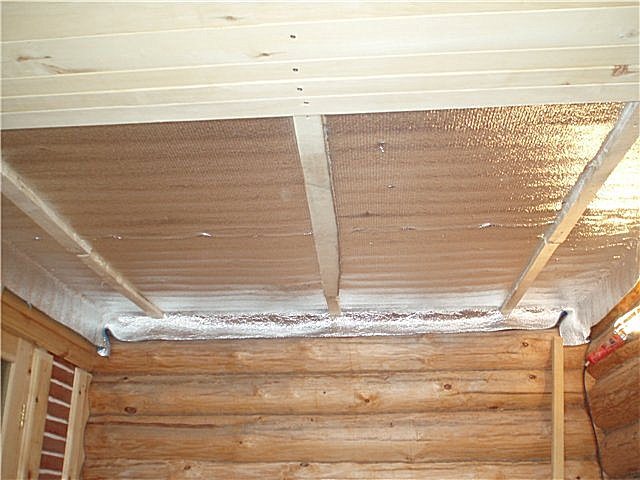

It must be remembered that penofol helps not only to keep the rooms warm in winter. If you lay it at the bottom of the roof, then it will prevent the penetration of the summer heat.
Types of reflective insulation for home
Insulation for walls can be either ordinary foil or insulation with foil on one or both sides. The principle of operation of such a system is based on the reflection of infrared rays. The foil itself can be insulation, but it is more appropriate to call it “reflective insulation”.
Insulation can be:
- Styrofoam;
- Closed cell polyethylene foam;
- Mineral or stone wool.
All heaters can be sold both in layers and in rolls. The safest is considered to be filtrated insulation with stone wool. It is mainly used for baths, since the material is non-toxic and does not allow moisture to pass through. Due to these properties, reflective thermal insulation can be used for chimneys and any other heating surfaces.
Polymer insulation cannot be used for surfaces with temperatures above 85 degrees.
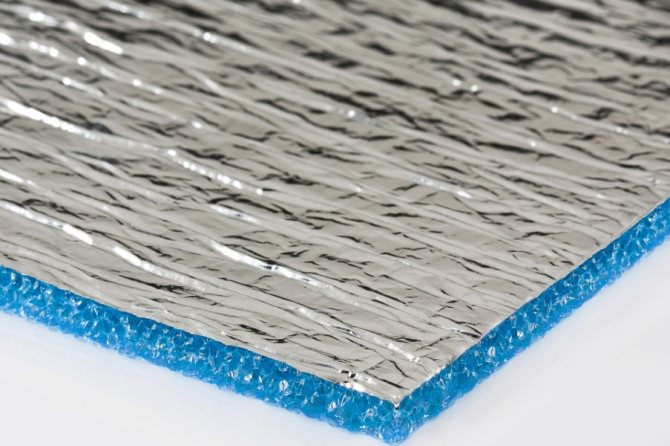

Plastic or polyethylene begin to lose their properties at temperatures above 90 degrees. In addition, polymers are used only for internal use. The exception is the pipe boxes. When cladding a house, the effectiveness of polymers as insulation is not observed. But sound insulation and wind barrier are provided.
How to choose penofol
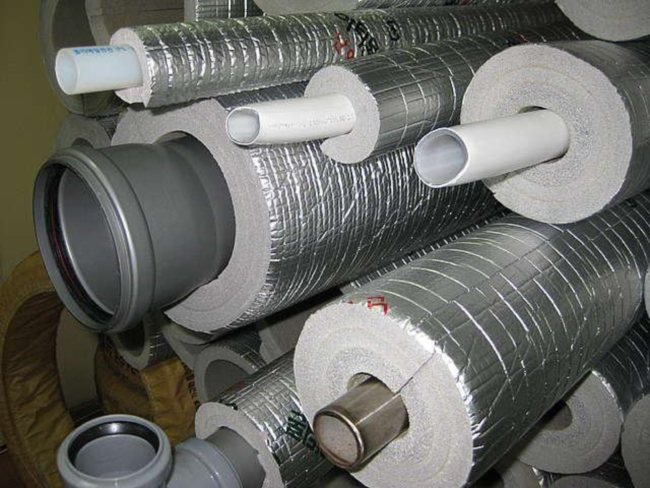

It is recommended to consider the following criteria for choosing penofol:
- On the the price the thickness affects, as well as how many layers of aluminum were applied to the reflective surface. The standard size is from three to eight or even ten mm. Penofol with one side - a reflector with a size of 3 or 4 mm by type A may cost about up to 55 rubles / m². 10mm by type B is considered much more expensive and more durable of all, the cost for it can reach from 100 to 130 rubles / m².
- In stores, you can stumble upon the "Penofol 2000" label. This is an analogue of the standard material, but cheaper (it costs from 35 rubles / m²). In terms of strength, according to experts, it is much inferior to the classic insulation.
- The best ratio between the cost of the substance and the performance data shows penofol 5 mm thick at a cost of approximately 70 rubles / m².
- When you need to insulate the roof or basement rooms, in the basement, on the balcony, for saunas, or walls and ceilings - you can use A-type of foam foam. When applied on wood floors, it is better to take the B-class. C-class is used for metal structures and car insulation.
Loggia insulation technology
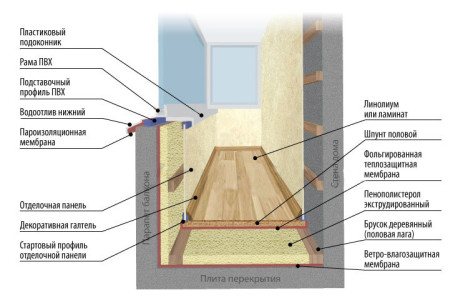

Balcony insulation scheme from the inside.
The insulation of the loggia, as mentioned above, should cover the walls, floor and ceiling.
Insulation of the walls of the loggia with penofol is carried out as follows. First, you need to clean the walls of debris, remove nails and screws, level the surface.
It should be as flat as the floor. In the presence of cracks and defects, they must be filled with polyurethane foam.
If necessary, plaster or putty can be used for leveling.
Thermal insulation includes a layer of foam, foam and facing material.
It is recommended to start insulation from the far corner of the loggia. To do this, take a penoplex slab and attach it to the wall. Then fix it with dowels or glue it. In the first case, you will need to drill at least 5 holes for fasteners in the plate and the wall.
It is necessary to fasten the foam boards in such a way that the vertical seams do not coincide. The plates on the sides have grooves for a tighter adhesion to each other. It is important not to leave gaps. In most cases, when installing the last plates, you will have to adjust them.For this, a section of the wall is first measured, and then a slab of the same size is cut out. The material is easily cut with a simple knife.
Back to the table of contents
How to lay penofol with your own hands
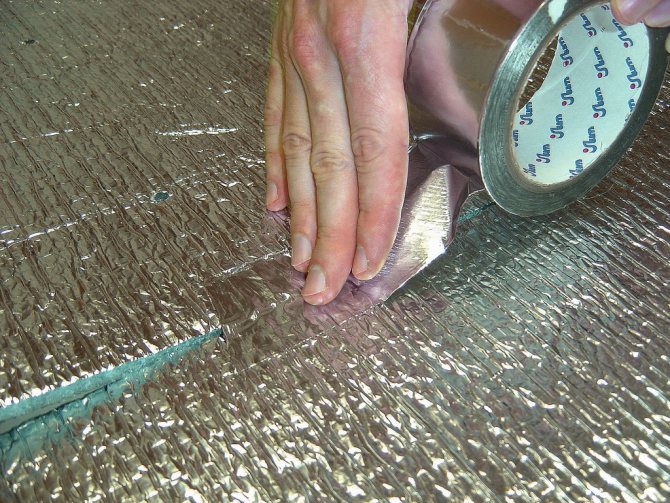

The best insulating effect is achieved if you adhere to the following rules:
- Between the structural element and the insulation itself, you need to leave some distance for ventilation, no more than a couple of centimeters.
- If you mount one-sided penofol, the layer with the foil must be directed to the side where the heat will come from.
- It is better to join the sheets of material joint to joint, which gives uniformity in the reflection of heat. But if, for example, a loggia is insulated, joining by the overlap method to a width of up to 10 cm is also permissible.
- When the joints of sheets of materials are sealed, tape should be used, also foil-clad.
It is very important to remember that this material must be fastened taking into account the fact that the reflective aluminum foil conducts current. Therefore, if there is a wiring nearby, it is necessary to insulate the wires well.
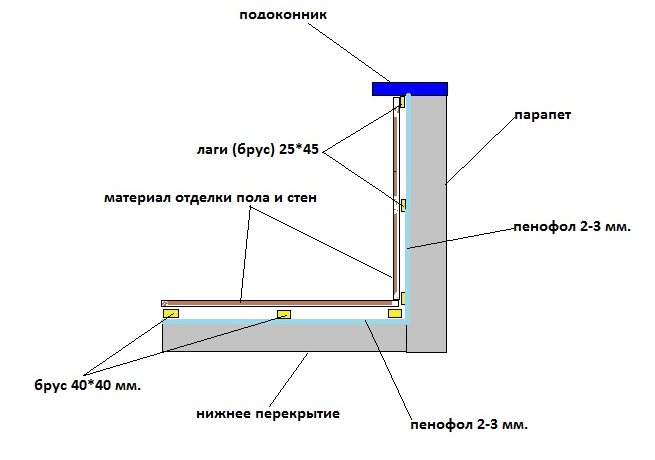

An example of using penofol for insulating walls and floors
After a material suitable for the operational requirements has been selected, additional waterproofing can be used, protection from steam or heat can no longer be used. It will also be possible to save on the installation process and materials necessary for high-quality insulation and surface insulation. You can also watch several videos on this topic.
Recommendations
Referring to the above, it can be noted clear boundaries use of building materials. So, if you need to insulate a summer cottage, a bathhouse, a gazebo or create a screen of heating devices that will retain heat in the room, feel free to choose penofol. Do not forget that the installation is made with the foil side to the energy source, and the ventilation joints (2-2.5 mm) must be sealed with foil tape. Also, the material is perfect for sound insulation, waterproofing and vapor barrier of the roof, ceiling and floor. For work with external walls, it is better to use Penofol as additional protection.
Penoplex will be a good solution for installation where vapor barrier properties are not needed. Otherwise, do not forget to do additional work. Thermal insulation of external walls, plinths and basements is the best option for using the material. Installation, unlike penofol, is best done with the help of specialists... This will help avoid unpleasant consequences and save money.
Renovation and construction

